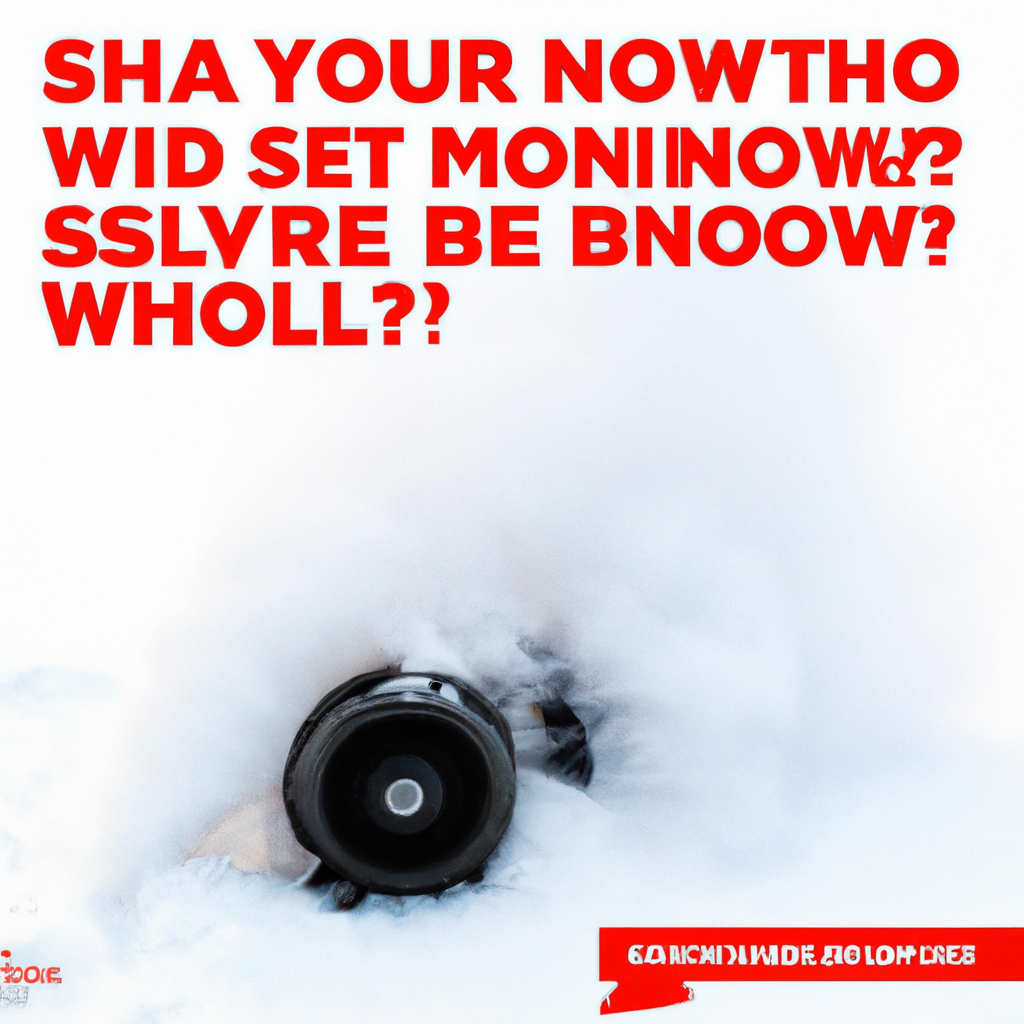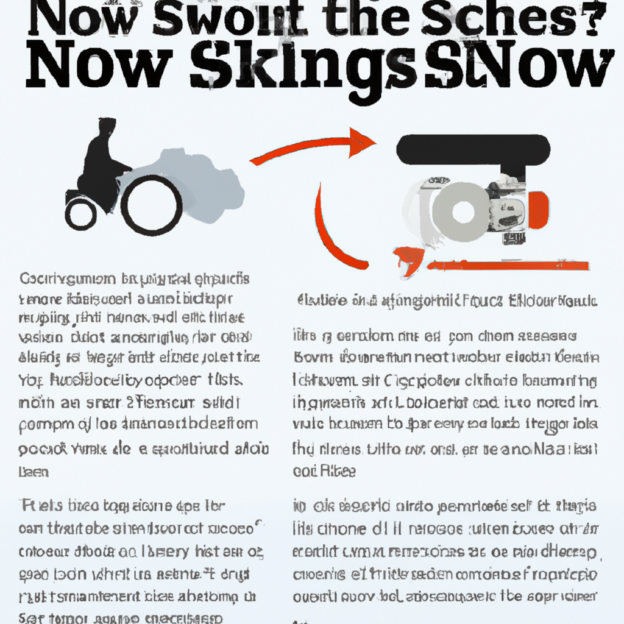So, picture this: You wake up to find a fresh layer of snow outside. You grab your trusty snowblower and confidently make your way to clear the driveway. But suddenly, you notice something alarming – your snowblower starts smoking! Panic sets in as you wonder what you should do in this situation. Before you start envisioning costly repairs or a ruined winter season, take a deep breath. In this article, we’ll guide you through the steps to take if your snowblower starts smoking, so you can quickly get back to conquering the snow-covered streets.

Causes of Smoking Snowblower
When your snowblower starts smoking, it’s important to first understand the potential causes so that you can effectively troubleshoot and resolve the issue. Here are some common reasons why a snowblower might smoke:
1. Oil or fuel leak
One of the main causes of a smoking snowblower is an oil or fuel leak. If there is a leakage in the fuel line or from the engine, it can result in the production of smoke. It’s important to inspect the area around the fuel tank and engine for any signs of leakage, such as puddles or a strong odor.
2. Clogged engine or air filter
A clogged engine or air filter can also lead to a smoking snowblower. When the engine or air filter becomes blocked with debris, it can restrict the flow of air and cause the engine to overheat, resulting in smoke. Regular cleaning and maintenance of the engine and air filter can prevent this issue.
3. Excessive oil in the engine
If there is too much oil in the engine, it can cause the snowblower to smoke. This usually happens when the user overfills the oil reservoir or fails to drain old oil properly before adding new oil. It’s essential to follow the manufacturer’s instructions regarding the correct oil level for your specific snowblower model.
4. Blocked muffler or exhaust system
A blocked muffler or exhaust system can restrict the flow of exhaust gases, leading to a smoking snowblower. Debris, such as snow or ice, can accumulate in the muffler or exhaust pipe, causing smoke to escape. Regularly checking and cleaning the muffler and exhaust system can help prevent this issue.
5. Overheating engine
If the engine of your snowblower becomes overheated, it can generate smoke. This can occur due to various reasons, such as the accumulation of debris, low oil levels, or improper fuel mixture. Ensuring proper maintenance and monitoring the engine’s temperature can help prevent overheating and subsequent smoking.
Safety Precautions
Before you begin troubleshooting the issue with your smoking snowblower, it’s essential to prioritize your safety. Here are some safety precautions to follow:
1. Turn it off immediately
As soon as you notice your snowblower smoking, the first step is to turn it off immediately. This will help prevent any further damage or potential safety hazards.
2. Move to a well-ventilated area
Once the snowblower is turned off, move it to a well-ventilated area. Operating the machine in an open, outdoor space will help minimize the risk of inhaling harmful smoke and fumes.
3. Allow the snowblower to cool down
After moving the snowblower to a safe location, allow it to cool down completely. This will prevent any potential burns or injuries when working on the machine.
4. Put on protective gear
Before you start troubleshooting the smoking snowblower, it’s crucial to put on protective gear. This may include safety goggles, gloves, and ear protection to safeguard yourself from any potential hazards.

Steps to Troubleshoot Smoking Snowblower
Now that you’ve taken the necessary safety precautions, you can proceed with troubleshooting the smoking snowblower. Here are the steps to follow:
1. Inspect for oil or fuel leaks
Carefully inspect the snowblower for any signs of oil or fuel leaks. Look for puddles or stains around the fuel tank and engine. If you detect a leak, it’s important to fix it before further using the snowblower.
2. Check the engine air filter
Remove the air filter and inspect it for any clogs or dirt. A dirty or clogged air filter can restrict airflow, leading to smoke production. Clean or replace the air filter if necessary, following the manufacturer’s instructions.
3. Ensure correct oil level
Check the oil level in your snowblower’s engine. If it exceeds the recommended level, carefully drain the excess oil according to the manufacturer’s instructions. Make sure to use the correct type of oil as specified in the user manual.
4. Clean the muffler and exhaust system
Inspect the muffler and exhaust system for any blockages. Remove any snow, ice, or debris that may have accumulated in these areas, using a cloth or brush. It’s essential to clean these components regularly to promote proper exhaust flow.
5. Check for signs of overheating
Examine the engine for signs of overheating, such as discoloration, strong fuel odor, or unusual noises. If you suspect overheating, investigate the cause, which could be a result of low oil levels, improper fuel mixture, or other mechanical issues.
Solutions When You Find a Problem
After troubleshooting your smoking snowblower, you may come across specific issues that need to be addressed. Here are some solutions for common problems:
1. Fix leaks and replace damaged parts
If you discover any leaks or damaged parts during the inspection, it’s vital to fix them promptly. Replace any faulty components, such as fuel lines or gaskets, and ensure everything is properly sealed.
2. Clean or replace the engine air filter
If the air filter is dirty or clogged, clean it thoroughly or replace it with a new one. A clean air filter promotes better airflow and prevents smoke production.
3. Adjust oil level if necessary
If you find that the oil level exceeds the recommended amount, carefully drain the excess oil according to the manufacturer’s instructions. Maintaining the correct oil level helps prevent smoke and engine damage.
4. Clear any blockages in the muffler or exhaust
If the muffler or exhaust was blocked, clean it thoroughly to remove any obstructions. Regularly inspecting and cleaning these components will ensure proper exhaust flow and minimize smoke production.
5. Identify and fix the cause of overheating
If your snowblower was overheating, identify the underlying cause and address it accordingly. This may involve checking for proper oil levels, verifying the fuel mixture, or seeking professional assistance for more complex mechanical issues.
When to Seek Professional Help
While many smoking snowblower issues can be resolved through troubleshooting, there are situations where professional help is necessary. Here are some scenarios in which you should consider seeking assistance:
1. Lack of experience or knowledge
If you’re unsure about how to troubleshoot or fix the smoking snowblower issue, it’s best to leave it to a professional. Lack of experience or knowledge can potentially lead to further damage.
2. Extensive damage or mechanical issues
If you discover extensive damage or complex mechanical issues during your troubleshooting process, it’s advisable to consult a professional technician. They will have the expertise and tools to address these problems effectively.
3. Persistent smoking after troubleshooting
If your snowblower continues to smoke even after following the troubleshooting steps, it indicates a more significant underlying problem. In such cases, it’s essential to seek professional help to prevent further damage and ensure your safety.
Regular Maintenance to Prevent Smoking
To avoid encountering a smoking snowblower in the future, it’s important to prioritize regular maintenance. Here are some maintenance tips to help prevent smoke-related issues:
1. Clean and inspect the snowblower regularly
Regularly cleaning your snowblower, including the engine, air filter, and exhaust system, will prevent the accumulation of debris, which can lead to smoking. Perform visual inspections to identify any potential problems before they escalate.
2. Change fuel and oil as recommended
Follow the manufacturer’s guidelines for fuel and oil changes. Using fresh fuel and changing the oil at the recommended intervals ensures optimal performance and reduces the likelihood of smoking.
3. Keep the engine well-lubricated
Proper lubrication of the snowblower’s engine is crucial to prevent overheating and smoking. Regularly lubricate moving parts according to the manufacturer’s instructions to keep the engine running smoothly.
4. Avoid overworking the machine
Avoid overworking your snowblower by adhering to its limitations and recommended usage guidelines. Overworking the machine can strain the engine and lead to excessive smoke production.
5. Store the snowblower properly
During the off-season, store your snowblower in a clean, dry area to prevent moisture and rust buildup. Follow the manufacturer’s instructions for proper storage, including fuel and oil removal if necessary.
By following these regular maintenance practices, you can minimize the chances of encountering a smoking snowblower and ensure its longevity and optimum performance.
In conclusion, when your snowblower starts smoking, it’s important to promptly address the issue to prevent further damage and potential safety hazards. Understanding the potential causes, taking necessary safety precautions, and following the troubleshooting steps can help you identify and resolve the problem. If needed, don’t hesitate to seek professional assistance for more complex issues. Finally, prioritizing regular maintenance practices will help prevent smoking and ensure the efficient operation of your snowblower.
